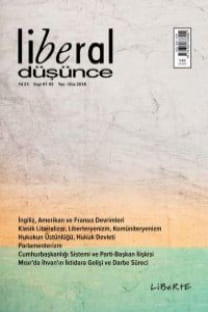İslam’da Sivil Din Ne Anlama Gelir?
Sivil din, İslam, Hristiyanlık, Tarikat, Sivil Toplum Kuruluşları, Devlet
Civil Religion, Islam, Christianity, Tariqah, Nongovernmental Organization, State,
___
- Açıkgenç, Alparslan (1990). “The Thinker of Islamic Revival and Reform: Fazlur Rahman’s Life and Thought (1919-1988)” in Journal of Islamic Research, Vol.4, No:4, October 1990, pp. 232-252.
- Ataman, Kemal (2014). “Sivil Din Üzerine Bir Söyleşi” in Bülent Ecevit Üniversitesi İlahiyat Fakültesi Dergisi, vol.1, issue:2, pp.151-166.
- (Avaliable at: http://dergipark.ulakbim.gov.tr/beuifd/article/view/5000087092 - Access on: 4.5.2015)
- Bellah, Robert N. and Philip E. Hammond (1980). Varieties of Civil Religion. Harper & Row Publishers, San Francisco.
- Breslauer, Daniel J. (2005). “Covenant and Civil Religion: Co-opting Religion and Religion Co-opted” in Introduction: America as Religion Mad. University of Kansas University. (Avaliable at: http://kuscholarworks.ku.edu/handle/1808/366 - Access on: 19.04.2015)
- Cole, Wade M. (2011). “Civil Religion for World Society: The Direct and Diffuse Effects of Human Rights Treaties, 1981-2007”
- Cuoto, Richard and Eric Thomas Weber (2010) “Civil Religion”, Chapter 57 in Political and Civic Leadership: A Reference Handbook, edited by Richard Couto, Washington, D.C.: Sage Press, p.505-512
- Ferrari, Alessandro (2010). “ Civil Religion in Italy: A Mission Impossible?” in The Goerge Washington International Law Review, Vol.41, pp. 839-859. (avaliable at: http://docs. law.gwu.edu/stdg/gwilr/PDFs/41-4/5-%20Ferrari.pdf) (Access on: 20.4.2015)
- Ferrari, Silvio (2011). “Religion and The Development of Civil Society” in International Jour- nal for Religious Freedom (ijrf), Vol. 4, issue 2, pp.29-36)
- Gorski, Philip S. (2010). Civil Religion Today (ARDA Guiding Paper Series). State College, PA: The Association of Religion Data Archives at The Pennsylvania State University, from http://www.thearda.com/rrh/papers/guidingpapers.asp.
- İnalcık, Halil (2003). “Tarihsel Bağlamda Sivil Toplum veTarikatlar”, in Bursa’da Dünden Bu- güne Tasavvuf Kültürü-2, (Ed. Nahit Kayabaşı), Bursa Kültür Sanat ve Turizm Vakfı Yayınları, Bursa.
- Kahla, Elina (2014). “Civil Religion in Russia” in HELDA - Digital Repository of the University of Helsinki.
- Avaliable at: https://helda.helsinki.fi/bitstream/handle/10138/136318/kahla_civil_religion. pdf?sequence=1 (Access on: 20.4.2015)
- Konur, Himmet (2012). “Zühdden Tasavvufa Geçiş” in Tasavvuf – El Kitabı. (Ed. Kadir Köse), Grafiker Yayınları, Ankara, pp.137-156.
- Kurt, Abdurrahman (2001). “Sosyo-Ekonomik ve Kültürel Yöntem İslam Öncesi Mekke Toplu- mu”, Uludağ Üniversitesi İlahiyat Fakültesi Dergisi içinde, c.10, sayı:2, ss.97-122.
- Michiaki, Okuyama (2012). “Civil Religion in Japan?- Rethinking the Arguments and Their Implications” in Religious Studies in Japan, Vol.1, pp.61-77. Avaliable at: http://jpars. org/online/wp-content/uploads/2012/04/RSJ-1-OKUYAMA.pdf (access on 20.4.2015)
- Mittleman, Alan (2001) “Pluralism: Identity, Civility, and the Common Good,” in Modern Jud- saism Vol. 21, no. 2, p.129.
- Öngören, Reşat (2012). “Tasavvufun Kurumsallaşması” in Tasavvuf – El Kitabı. (Ed. Kadir Köse), Grafiker Yayınları, Ankara. pp. 217-311.
- Reader, Ian (1994). “Civil Religion in Japan” in The Copenhagen Journal of Asian Studies, Vol.9, pp. 9-31.
- ISSN: 1300-8781
- Başlangıç: 1996
- Yayıncı: Liberte Yayınları
Yurda Geri Dönüşün Anlamı ve Hz. Muhammed’in Ermeni Ahitnamesi
Tek-Parti Döneminde Akademik Bir Dergi: Siyasî İlimler Mecmuası
İslâm Öncesi Mekke’de Sivil Toplum
İslam’da Sivil Din Ne Anlama Gelir?
Frédéric Bastiat: Fransız Devrimi ve Marjinalist Devrim Arasında
Thomas J. DİLORENZO, Ünsal ÇETİN
Anarko Kapitalizm Üzerine Bir(inci) İnceleme Piyasa Anarşizmi Nedir?
Başkanlık Sistemi Tartışmalarına Standart Bir Liberal Yaklaşım Mümkün mü?
Murray N ROTHBARD, Bahadır AKIN
